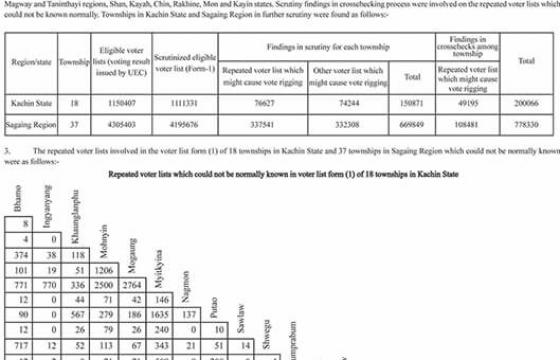Commander-in-Chief Min Aung Hlaing’s recent China visit, United Wa State Army (UWSA) – National Democratic Alliance Army (NDAA) military friction or debacle and Burma Army’s withdrawal ultimatum of the UWSA troops from its occupied positions in NDAA territory have been important developments during the past few weeks, which have raised concerns and worries among the stakeholders of the country that are trying to iron out a nationwide peace deal.
From the outset, the UWSA has been quite skeptic to participate in the Union Peace Conference (UPC), also dubbed 21st Century Panglong (21CPC), held from 31 August to 3 September, even though it had sent in a low-level functionaries because of China’s urging, while the NDAA was quite enthusiastic and participated in the gathering headed by its leader Sai Luen, also known as Lin Mingxian, until the end of the conference.
The UWSA, however, opted out of the conference after just a day of attending, stating unfair treatment and discrimination over status of participation. Reportedly, the Wa delegation was given observer status, instead of the full-fledged participant cards. Apologies from the conference conveners blaming technical error came to no avail, as the delegation left the conference the following day.
UWSA-NDAA soured relationship
The NDAA, based in eastern Shan State’s Mongla Township (officially known as Shan State Special Region 4), has traditionally maintained close relations with the Wa army, which is considered the largest ethnic militia force in Burma with a troop strength estimated at 20,000. Commonly referred to as the Mongla Group, the NDAA has around 3,000 soldiers, according to data from the Myanmar Peace Monitor.
On September 28, the UWSA sent in its Battalion 468 – some 600 troops pulled into NDAA territory in about 60 trucks. The Wa forces seized three NDAA bases: two mountain bases, Loi Kiusai and Loi Hsarm Hsoom, and a checkpoint at Parng Mark Fai. More than 150 NDAA guards were captured in the raids.
The NDAA troops were released later, but the occupation of the military bases continue with more reinforcement, even after the negotiation conducted between the UWSA and the NDAA, reportedly with the Chinese mediator on the Chinese side, a few weeks ago.
The NDAA’s drift towards the military’s and government’s orbit worried the UWSA tremendously, which resulted in the occupation of the military outposts in Mongla considered to be militarily, logistically and economically strategic for the UWSA.
The NDAA has been demanding a self-administered zone for the Akha ethnic minority, which it has made known that if accepted would lead to its signing of the Nationwide Ceasefire Agreement (NCA).
This is relatively easy to achieve as according to U Ye Htun, a prominent former Shan MP during the previous regime, in his article in Democratic Voice of Burma on 8 November, the constitution’s paragraph number 54 could make it necessary. He said, the concerned Chief Minister of State only needs to endorse the proposal and forward it to the President, where he could decide as he sees fit, without going through the parliament.
Besides the area being strategically important, it is also the territory that the UWSA wanted to incorporate into its Wa State aspirations, according to its historical claim’s document that was made known, during the 21st Century Panglong Conference.
Burma Army’s ultimatum
The Burmese armed forces have ordered the United Wa State Army (UWSA) to withdraw all its troops from territory under the control of the National Democratic Alliance Army (NDAA), by 24 October deadline, in and around the town of Mongla in eastern Shan State, according to Luo Zai Nub, an official from the UWSA, reported SHAN.
“We and the Mongla are brothers,” he said. “We are here to support each other. We have been here since 2009. We cannot move out if we do not get orders from our headquarters.”
Luo Zai Nub said that on 22 October the day the official request of withdrawal was made, two Burmese government military jets flew overhead. The following day, Sunday, another four planes conducted reconnaissance missions over Mongla, which borders China.
The UWSA refused to obey the Burma Army’s withdrawal deadline, but instead just sent a reply to the government’s query on the situation, saying that it would resolve the conflict peacefully with the NDAA to the government’s vice chairperson of Peace Commission (PC) Dr Tin Myo Win and Aung San Suu Kyi’s top peace negotiator.
Following the UWSA refusal to withdraw, the beefing up and reinforcement of the Burma Army was carried out. According to Jane’s Defence Weekly of 31 October, the Tatmadaw mobilized assets under the Kengtung-based Triangle Region Command, including infantry battalions, tribal militia units and Chinese-built PTL-02 armored fighting vehicles.
Consequently, according to Myanmar Times of 27 October, around a thousand troops of the UWSA were manning the occupied outposts.
Chinese mediation
According to U Ye Htun, the Shan politician and observer of Burma’s politics, the UWSA seems to be keen on resolving its conflict with the Burma Army peacefully, although it wouldn’t withdraw its troops from the occupation of three military outpost in Mongla.
He reasoned that the UWSA might have asked China to intervene, as Chief of the Joint Staff of the People’s Liberation Army, General Fang Feng-hui invited Min Aung Hlaing and later also met Major General Yu Kun, political commissar of Yunnan military region.
According to Myawady News of 4 November, Min Aung Hlaing said the over 2,000-kilometer long border mostly shares with Yunnan Province. Most of the national races of both countries living on the border came from the same tribe so they can be called brethren. Now, we are continuing to further cement the amicability built by the former leaders of the two militaries (China and Burma). Efforts will also be made for continued exchange of goodwill visits, meetings for border affairs, promotion of military industry sector and military training and border security and development together with the Southern Theater Command.
On 28 October, BBC reported that NDAA and UWSA also met in China, which was said to be productive and smooth but reportedly the occupied outposts by the UWSA wouldn’t be withdrawn.
Perspective
The unfolding political situation could be assessed in the light of national interest, ethnic groups’ aspirations, proxy war and deterrence.
First of all, China’s first priority is to interact with Burma as a whole unit that caters to its national interest. This includes satisfying or fulfilling its energy hunger; global, regional economic schemes; and backing for its claim on what is being accepted international sea lane, including the sea territorial disputes with various Southeast Asian countries and so on. In other words, realization of the Irrawaddy Myitsone Dam, Salween Dam and the likes that have been stalling, Kyaukpyu-Kunming railway project and seeking endorsement of its one China policy and its claim of legitimacy rule over Xinjiang, coupled with the backing for its South China sea claims, among others.
As such, China is interested to deal Burma only as a whole unit so that its national interest could be realized accordingly, not selectively with ethnic groups along the border economically. This clearly rejects the Burmese military’s often stated rhetoric dismemberment notion of the country and statements such as losing an inch of the country’s territory won’t be tolerated and dealt with decisively. China is not at all interested in the breaking up of Burma, in any way.
That is why China is for a peaceful Burma for its own reason and is ready to use its weight where necessary to achieve it.
China’s urging to its proxies like UWSA and NDAA to participate in the last 21CPC after the Aung San Suu Kyi China visit is the case in point. But this doesn’t mean China would join hands in using military pressure to disarm or block the border, to help Burma defeat the ethnic armies.
This is evident when one looks at the military hardware sales to both the Burma Army and also to the UWSA.
Khernsai Jaiyane, Director of the Pyidaungsu Institute when interviewed by SHAN on 4 November, regarding Min Aung Hlaing’s China visit, whether it could de-escalate the military confrontation between the Burma Army and the UWSA, replied: “There are four or five possibilities. Number one is China supplies both Burma Army and also the UWSA. For example, China gives airplanes to the Burma Army and the anti-aircraft weapons to the Wa. What the Chinese want to say is that by going with this pattern, it doesn’t want them to fight. For if there is war both sides would die and suffer. Civilian will lose the most.”
Perhaps, like Khernsai said, the Chinese government looks at it involvement as a kind of deterrence to help avoid the war between Burma Army and the UWSA.
He added that the UWSA allies like Kachin Independence Army (KIA), Arakan Army (AA), Ta’ang National Liberation Army (TNLA), Myanmar National Democratic Alliance Army (MNDAA) and Shan State Army -North (SSA-N) are fighting the Burma Army. And if the UWSA will join the fray, the war will spread to northern, central and eastern parts of Shan State.
Particularly, he was quite concerned of a brewing proxy war, with Burma Army backed by one powerful nation and the Wa, by another. He said nobody could say for sure that the recurrence of China backing the Communist Party of Burma (CPB) during the Cold War scenario would not happen again, in the setup of China backing the UWSA.
As for the Min Aung Hliang’s China visit, for now it seems the Chinese has been able to persuade the Burma Army not to opt for an open warfare against the UWSA. But also highly unlikely that Min Aung Hlaing was able to woo the Chinese to subdue the UWSA.
And where NDAA is concerned, it has to swallow the hard reality of having to agree to the UWSA troops stationing on its territory reluctantly, due to the security and strategic concern of the latter, for the time being.
All in all, it looks like that the UWSA has benefited in two ways by using the Chinese card. One is that it was able to stop the Burma Army military advance and likely offensive with the help of China and the other, it could pull the NDAA back from getting too close to the government, through the use of force and with argument that sacrificing the strategically important chunk of territory would be unwise, which is vital for the survival of both organizations.
For the time being, Chinese deterrence strategy and persuasion are able to defuse an all out war between the UWSA and the Burma Army. Only it is not clear, whether this would be the case the next time such confrontation occurs, without a comprehensive peace treaty and holistic political settlement still in sight.






